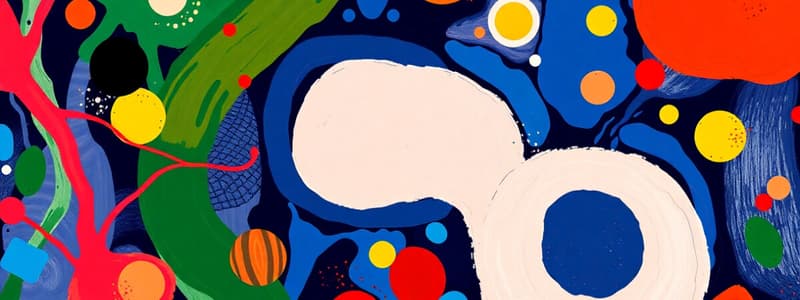Podcast
Questions and Answers
What is produced in every turn of beta-oxidation?
What is produced in every turn of beta-oxidation?
- 1 NADH and 1 FADH2 (correct)
- 1 Propionyl CoA
- 1 ATP
- 2 Acetyl CoA
Every step in beta-oxidation produces 2 NADH.
Every step in beta-oxidation produces 2 NADH.
False (B)
How many Acetyl CoA molecules are formed from the complete oxidation of palmitic acid?
How many Acetyl CoA molecules are formed from the complete oxidation of palmitic acid?
8
During fatty acid synthesis, Acetyl CoA and _______ are used as starting materials.
During fatty acid synthesis, Acetyl CoA and _______ are used as starting materials.
Match the types of fatty acids with their characteristics:
Match the types of fatty acids with their characteristics:
What is the primary function of bile acids in lipid digestion?
What is the primary function of bile acids in lipid digestion?
Chylomicrons are responsible for the transport of triacylglycerols in the lymphatic system.
Chylomicrons are responsible for the transport of triacylglycerols in the lymphatic system.
Name two types of lipoproteins that transport lipids in the bloodstream.
Name two types of lipoproteins that transport lipids in the bloodstream.
The products of lipase digestion form __________ for absorption by the intestinal cells.
The products of lipase digestion form __________ for absorption by the intestinal cells.
Match the lipid pathway with its corresponding function:
Match the lipid pathway with its corresponding function:
Which enzyme is primarily responsible for the digestion of triglycerides in the intestine?
Which enzyme is primarily responsible for the digestion of triglycerides in the intestine?
Fatty acids with an odd number of carbon atoms are metabolized into Acetyl-CoA and Propionyl-CoA.
Fatty acids with an odd number of carbon atoms are metabolized into Acetyl-CoA and Propionyl-CoA.
What type of bonds do sphingophospholipids contain, based on their structure?
What type of bonds do sphingophospholipids contain, based on their structure?
What is the primary role of lipids in biological systems?
What is the primary role of lipids in biological systems?
Phospholipids contain a hydrophobic tail and a hydrophilic head.
Phospholipids contain a hydrophobic tail and a hydrophilic head.
What are the three main components of a triacylglycerol?
What are the three main components of a triacylglycerol?
Lipids that are widely used for energy storage are called ______.
Lipids that are widely used for energy storage are called ______.
Match the following lipid types with their descriptions:
Match the following lipid types with their descriptions:
Which type of lipid serves as insulation and provides energy storage?
Which type of lipid serves as insulation and provides energy storage?
Waxes are a type of lipid that is soluble in water.
Waxes are a type of lipid that is soluble in water.
What is the structural difference between saturated and unsaturated fatty acids?
What is the structural difference between saturated and unsaturated fatty acids?
Flashcards
Lipids
Lipids
Molecules that are insoluble in water but highly soluble in organic solvents.
Hydrophobic
Hydrophobic
The property of a molecule that repels water.
Hydrophilic
Hydrophilic
The property of a molecule that attracts water.
Fatty Acids
Fatty Acids
Long chains of hydrocarbons with a carboxylic acid group at one end.
Signup and view all the flashcards
Glycerol
Glycerol
A three-carbon alcohol that forms the backbone of many lipids, including triacylglycerols and phospholipids.
Signup and view all the flashcards
Triacylglycerol
Triacylglycerol
A type of lipid that stores energy in adipose tissue. Formed from glycerol and three fatty acids.
Signup and view all the flashcards
Phospholipids
Phospholipids
A type of lipid that forms the structural basis of cell membranes. They have a glycerol backbone, two fatty acid chains, and a phosphate group.
Signup and view all the flashcards
Sphingosine
Sphingosine
The molecule that forms the backbone of sphingolipids. It has a long hydrocarbon chain and an amino group.
Signup and view all the flashcards
Beta-oxidation
Beta-oxidation
A process where fatty acids are broken down into two-carbon units (acetyl-CoA) to generate energy. It occurs in the mitochondria and involves multiple steps, including activation, transport, and beta-oxidation.
Signup and view all the flashcards
Fatty acid activation
Fatty acid activation
The first step of fatty acid oxidation, where the fatty acid is activated by attaching it to coenzyme A (CoA) using energy from ATP.
Signup and view all the flashcards
Beta-oxidation cycle
Beta-oxidation cycle
A series of repeating reactions that remove two-carbon units from the fatty acid chain in the form of acetyl-CoA. Each cycle produces NADH and FADH2, electron carriers used in oxidative phosphorylation to produce ATP.
Signup and view all the flashcards
Odd-chain fatty acid oxidation
Odd-chain fatty acid oxidation
A type of fatty acid oxidation that occurs when the starting fatty acid has an odd number of carbons. It results in the production of propionyl-CoA, which is then converted into succinyl-CoA and enters the citric acid cycle.
Signup and view all the flashcards
Fatty acid synthesis
Fatty acid synthesis
The process of building fatty acids from smaller units, primarily acetyl-CoA. It occurs in the cytosol and requires NADPH and ATP.
Signup and view all the flashcards
Lipid Digestion
Lipid Digestion
Lipids are broken down into smaller components through a series of enzymatic reactions. This process is facilitated by enzymes like lingual lipase in the mouth, gastric lipase in the stomach, and pancreatic lipase in the intestine.
Signup and view all the flashcards
Role of Bile Salts
Role of Bile Salts
Bile salts, produced by the liver, act as detergents that emulsify fats. They increase surface area, making it easier for lipases to work.
Signup and view all the flashcards
Lipid Absorption
Lipid Absorption
The products of lipid digestion are absorbed in the small intestine. This includes free fatty acids, cholesterol, and 2-monoacylglycerol. Fat-soluble vitamins (A, D, E, and K) are also absorbed here.
Signup and view all the flashcards
Lipid Transportation
Lipid Transportation
After absorption, lipids are reassembled into triacylglycerols and packaged into lipoprotein particles called chylomicrons. These particles transport lipids through the lymphatic system and into the bloodstream.
Signup and view all the flashcards
Lipoprotein Categories
Lipoprotein Categories
Lipoproteins are complexes that transport lipids in the blood. They are classified into different categories based on their density: chylomicrons, VLDL, LDL, and HDL. Each type has a specific role in lipid metabolism.
Signup and view all the flashcards
Fatty Acid Oxidation
Fatty Acid Oxidation
The breakdown of fatty acids into acetyl-CoA through a series of steps. This process occurs in the mitochondria and generates energy in the form of ATP.
Signup and view all the flashcards
Significance of Fatty Acid Oxidation
Significance of Fatty Acid Oxidation
Fatty acid oxidation is a critical process for energy production, particularly during periods of fasting or when carbohydrate intake is limited. This pathway provides an alternative energy source for the body.
Signup and view all the flashcardsStudy Notes
Lipids
- Lipids are defined as water-insoluble (hydrophobic) molecules, highly soluble in organic solvents.
- They have both hydrophilic (polar) and hydrophobic (nonpolar) regions, making them amphipathic.
- Lipids are crucial for energy storage, membrane structure, and signaling.
Learning Objectives
- Explain structural properties of lipids.
- Detail the roles of lipids.
- Categorize lipids.
- Identify fatty acids.
- Describe lipid digestion and absorption.
- Recognize steroids.
- Classify lipoproteins.
- Explain fatty acid catabolism (beta-oxidation).
- Explain fatty acid synthesis.
Types of Lipids
- Fatty acids
- Waxes
- Sphingolipids
- Terpenes
- Phospholipids
- Ceramides
- Steroids
- Triacylglycerides
- Eicosanoids
Roles of Lipids
- Energy storage: Lipids store energy more efficiently than carbohydrates as they require less water for storage.
- Membrane structure: Lipids are essential components of cell membranes, providing a barrier and facilitating communication.
- Signaling: Lipids serve as hormones and other signaling molecules, regulating various bodily functions.
- Thermal insulation: Lipids help maintain body temperature by acting as thermal insulators.
Triacylglycerols (TAGs)
- Storage lipids, made of glycerol and three fatty acids.
- Major energy storage form for the body, storing energy efficiently with less water.
- Found in adipose tissue.
Phospholipids
- Crucial component of cell membranes, featuring a glycerol backbone, two fatty acid chains, a phosphate group, and an additional polar group (e.g., choline, ethanolamine).
- Formation of cell membrane bilayers through the self-assembly property of phospholipids.
Glycolipids
- Lipids with carbohydrate groups attached, playing a crucial role in cell recognition and signaling in cell membranes.
- Component of blood types, playing a role in cell-to-cell recognition.
Steroids
- Four fused hydrocarbon rings structure, serving as hormones (e.g., estradiol, testosterone), bile acids, and cholesterol (structural component of cell membranes).
- Steroid hormones regulate various physiological processes.
Lipid Digestion
- Digestion begins in the mouth with lingual lipase activation.
- Stomach continues lipid digestion with gastric lipase, aided by bile salts.
- Pancreatic lipase in the small intestine further breaks down lipids into smaller molecules.
- Mechanical mixing (peristalsis) and emulsifying agents (bile salts) are essential for proper lipid digestion.
Lipid Absorption
- Lipids are absorbed by intestinal cells as fatty acids, monoglycerides, and cholesterol.
- Absorption involves formation of micelles in the intestinal lumen.
- Lipids pass directly through the cell membrane.
- Fat-soluble vitamins are absorbed with lipids.
Lipid Transport
- Absorbed lipids are packaged into lipoprotein particles (chylomicrons).
- These lipoproteins transport lipids throughout the body via the lymphatic system to the blood.
- Different lipoprotein types carry different lipid compositions (e.g., chylomicrons, VLDL, LDL, HDL) with different functions and density.
Lipoprotein Structure
- Lipoproteins are amphipathic structures composed of a core of hydrophobic lipids (TAGs, cholesterol esters) surrounded by a hydrophilic coat of proteins, phospholipids, and cholesterol.
Fatty Acid Oxidation
- Process where fatty acids are broken down to produce energy.
- Involves activation, transport into mitochondria, and the beta-oxidation cycle.
- Beta-oxidation removes two-carbon units from fatty acids, yielding acetyl CoA, NADH, and FADH2.
- These products enter the citric acid cycle to generate ATP.
- Odd-numbered fatty acids generate a different product, succinyl CoA, which is then processed in the citric acid cycle.
Fatty Acid Synthesis
- Processes that produce fatty acid molecules from acetyl CoA.
- The process involves cycles of adding two carbon units to a growing fatty acid chain.
- Uses enzyme acetyl CoA carboxylase which uses biotin as a coenzyme.
- Essential fatty acids are obtained solely through diet, and need desaturation and elongation in the body.
Studying That Suits You
Use AI to generate personalized quizzes and flashcards to suit your learning preferences.




